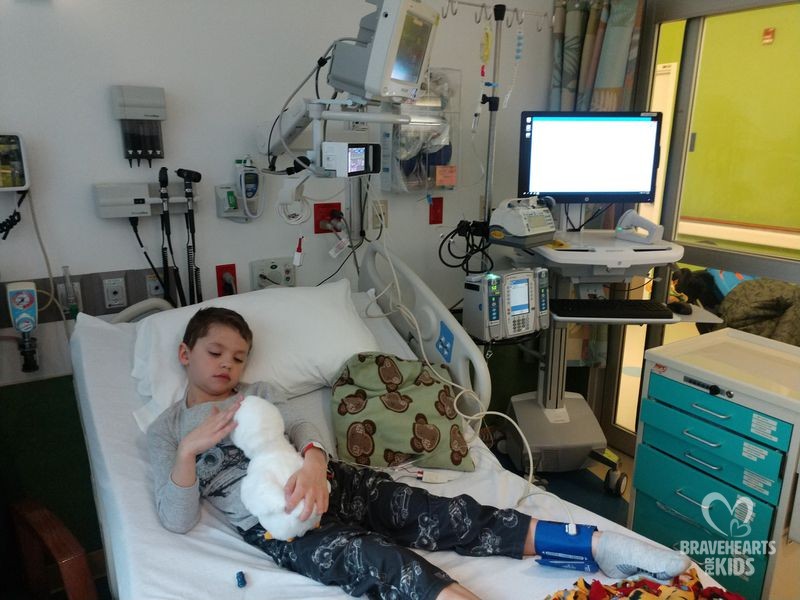Like many 6-year-olds, Chase Petersen loves Legos and pizza.
Unlike others, he has a port in his chest for cancer treatments.
Diagnosed with langerhans cell histiocytosis when he was 4 months old, Chase has been in and out of hospitals his whole life. When he needed to begin a year’s worth of chemotherapy treatment in January, his mother, Nichole Petersen, took a deep breath. She dreaded forcing him to return to a hospital.
She reminded herself of the bright spots at Lurie Children’s Hospital — the playroom full of toys, the familiar faces of staffers who work hard to brighten his day.
“He’s always loved the playroom at Lurie’s. That has always been a safe place for him, and for my daughter,” Nichole Petersen said.
Then, the pandemic happened.
Restrictive protocols meant only one parent could come, disrupting the family’s long-established routines to make hospital life easier — she now drove alone to and through the city from their home in Zion, no longer able to juggle tasks with Chase’s dad, Ben Petersen, who would get food and ensure she took care of herself too. Chase’s sister, Brooklynne, 10, also could no longer come along to the hospital, where she had gotten to know the staff.
And the playroom closed. Chase loved it there, where he could select toys he didn’t have at home and engage with art projects kept there.
Nichole Petersen wanted to cry.
“We were only two months into treatment, and then COVID happened, and literally the playrooms are gone. The toys, they’re not just put away — they’re not in the room,” she said. “You don’t realize how much the situation has trickled down to so many areas. There’s so many different facets and layers to the whole COVID thing that people forget.”
Staffers at Lurie worked to improvise — like many hospital workers during the pandemic, they tried to ease the added burdens on families already shouldering so many.
Sara Stewart is a child life specialist. Her role at Lurie includes supporting psychological care, as well as providing emotional and social support, for children, young adults and their families.
Stewart said the playroom serves as a refuge for children enduring medical procedures from chemotherapy to surgery. It’s a place to escape their room, to find toys and a bit of distraction. Children might make friends there, realizing they are not the only kid to carry around an IV pole.
“The children really thrive,” she said. “They feel like it’s their space; they have control over it.”
Isolating children to their rooms, she said, “makes it even harder to understand that they’re not the only child in the hospital; they’re not the only child going through this. It was really, really hard.”
Chase Petersen holds a stuffed toy duck during a September stay at Lurie Children’s Hospital.
Chase Petersen holds a stuffed toy duck during a September stay at Lurie Children’s Hospital. (Nichole Petersen)
She and other staffers created packages of toys, for age ranges from preschool to teenagers, that they selected depending on a child’s situation and brought directly to them. The packages include things like Uno, Play-Doh, or scratch art, something really popular among their patients — and a favorite of Chase’s. An Amazon wish list has items that people can buy as donations.
Toys help children process what they are experiencing. For example, a duck the hospital gave Chase has a port like his in its own furry chest. Stewart used the duck, which Chase dubbed Mr. Quackers, to talk about the port he would have during his chemotherapy.
The robotic duck, modeled after the Aflac duck and created by the company to be a companion for cancer patients, comes with emoji disks patients can use to talk through feelings, and can move its head while cuddling with patients.
“It was such a great distraction for him, because he loves toys, he loves playing with things,” Nichole Petersen said. “He was able to use Mr. Quackers to kind of share. … I think that was really powerful for Chase.”
Stewart and her colleagues found other ways to ease the challenges of COVID-19. Many children now need coronavirus tests before procedures; the staffers work to prepare their young charges, explaining the test — performed with a long Q-tip — and that it will take about 10 seconds.
Stewart tries to give options: Do they want to sit on a parent’s lap or by themselves? Which nostril should they use, and would they like to count to 10 together during the swab? Afterward, they plan something fun, like a game, favorite movie or ice cream.
Recently, the playroom reopened, with hourlong slots children have as appointments. Still, Stewart said, scheduling time can be tough for patients when a procedure can pop up at any time.
So they continue to deliver toys directly.
Chase’s treatment, they hope, will finish in December, just in time for the holidays. In the meantime, he uses the scratch art at the hospital, and he loves coordinating his clothes for a trip — pizza pajamas, pizza underwear. And Mr. Quackers stays with him, whether at the hospital or home.
“The one thing that has remained the same?” Nichole Petersen said. “We can still bring the duck.”
[/et_pb_text][/et_pb_column][/et_pb_row][/et_pb_section]







Most Commented